In the hustle and bustle of modern life, good sleep has become an elusive commodity that many of us yearn for. The importance of sound sleep goes beyond mere rest — it is the cornerstone of our overall well-being. But in the midst of a busy schedule and increasing stress, finding restful sleep can feel like an uphill battle. The incessant thoughts, racing heartbeat and struggle to find comfort in the embrace of darkness are all too familiar to those who wrestle with insomnia.
Our lives are tightly woven with responsibilities, deadlines and demands that leave little room for the rest that sleep requires. Stress, whether from work, relationships or other life factors, casts a long shadow over the serenity we need to drift off to sleep. This cycle of stress feeding into sleeplessness and sleeplessness exacerbating stress, can feel inescapable.
But there is hope- Relaxation Techniques are the key to a peaceful night’s sleep. By becoming aware of how much stress affects our quality of sleep, we can embark on a journey of self-care and rejuvenation. This article serves as a guide that gently walks you through a holistic realm of relaxation techniques tailored to repair the bridges between you and restful sleep. With these techniques, you can take back control of your nights and embrace the soothing embrace of sleep as a natural and rejuvenating process.
9 Effective Relaxation Techniques for Better Sleep
Relaxation Technique 1# Progressive Muscle Relaxation

Explanation- Progressive Muscle Relaxation (PMR) is a relaxation technique that involves tensing and then relaxing different muscle groups in your body. The idea behind PMR is to help you become more aware of the physical sensations associated with tension and relaxation. By consciously tensing and then releasing each muscle group, you can promote a deep sense of relaxation and calmness.
Benefits of Progressive Muscle Relaxation (PMR)
Progressive Muscle Relaxation offers several benefits that contribute to improved sleep-
- Reduces Muscle Tension- Tension in muscles can accumulate throughout the day due to stress and physical strain. PMR helps release this tension, leading to a more comfortable and relaxed body.
- Promotes Relaxation- By systematically relaxing muscle groups, PMR triggers a relaxation response in your body. This counteracts the stress response and encourages a state of calm.
- Aids Sleep– The relaxation induced by PMR can prepare your body for sleep. When your muscles are relaxed, it’s easier to let go of racing thoughts and anxiety that might hinder falling asleep.
Step-by-Step Guide to Performing Progressive Muscle Relaxation
- Find a Quiet Space- Choose a quiet and comfortable space where you won’t be disturbed for about 15-20 minutes.
- Get Comfortable- Lie down on your back or sit in a comfortable chair. Close your eyes and take a few deep breaths to begin the relaxation process.
- Start with Your Toes- Focus your attention on your toes. Curl them tightly and hold the tension for about 5-10 seconds. Release the tension suddenly and notice the sensation of relaxation. Pay attention to the contrast between tension and relaxation.
- Move Up the Body– Slowly progress through each muscle group. Tense the muscles in your feet, then your calves, thighs, buttocks, abdomen, chest, arms, hands, and finally, your face and scalp. Hold the tension for a few seconds and then release.
- Focus on Sensations- As you release each muscle group, pay attention to the feeling of relaxation spreading through your body. Notice the sensation of warmth and heaviness in the relaxed muscles.
- Breathe- Throughout the process, maintain slow and deep breathing. Inhale as you tense a muscle group, and exhale as you release the tension. This synchronised breathing enhances the relaxation effect.
- Progress at Your Own Pace- Go through all the major muscle groups, or choose specific areas where you feel tension. There’s no rush—take your time with each muscle group.
- End with Full Body Relaxation- After you’ve gone through all the muscle groups, allow yourself to experience the sensation of complete relaxation. Visualise your entire body feeling peaceful and tension-free.
- Take Your Time- Once you’ve completed the relaxation process, take a few moments to enjoy the calm state you’ve cultivated.
Progressive Muscle Relaxation is a simple and effective technique that can contribute significantly to better sleep. By systematically releasing tension in your muscles, you pave the way for a relaxed body and mind, which helps you to have a peaceful and restful night’s sleep. Incorporating PMR into your bedtime routine can be a valuable step towards improving your sleep quality and overall well-being.
Also Check – Ayurvedic Sleep Elixir- 14 Foods and Drinks for Restful Nights
Relaxation Technique 2# Deep Breathing Exercises
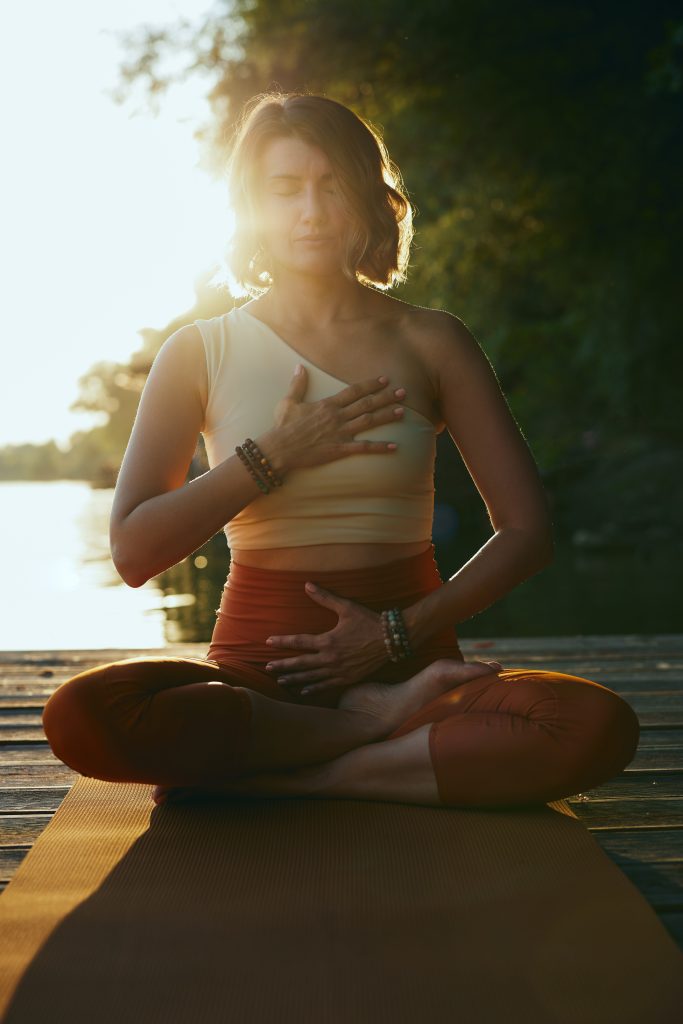
Significance of Deep Breathing in Calming the Nervous System
Deep breathing exercises are powerful tools that can help calm your nervous system and promote relaxation. When you’re stressed or anxious, your body enters a state of fight-or-flight response, which can hinder your ability to fall asleep. Deep breathing triggers the body’s relaxation response, reducing the heart rate, lowering blood pressure, and decreasing stress hormones. This shift in physiological state primes your body for restful sleep.
Types of Deep Breathing Techniques
Diaphragmatic Breathing
- Diaphragmatic breathing, also known as belly breathing, focuses on engaging the diaphragm—the muscle beneath your lungs—rather than shallow chest breathing. This technique encourages deeper and more efficient oxygen exchange, leading to a more relaxed state.
Instructions-- Find a quiet space and sit or lie down in a comfortable position.
- Place one hand on your chest and the other on your abdomen.
- Inhale slowly through your nose, allowing your abdomen to expand as your lungs fill with air. Let your chest remain relatively still.
- Exhale gently through your mouth, allowing your abdomen to contract as you release the air.
- Repeat this process for several breaths, focusing on the rise and fall of your abdomen.
Diaphragmatic breathing encourages slow, rhythmic breathing that activates the parasympathetic nervous system—responsible for the body’s relaxation response. This technique helps calm racing thoughts and reduces anxiety, making it easier to transition into a peaceful sleep.
4-7-8 Technique
The 4-7-8 technique, also called the relaxing breath, involves specific breath counts to create a calming effect on the body and mind.
Instructions-
- Sit or lie down comfortably and close your eyes.
- Inhale quietly through your nose for a count of 4.
- Hold your breath for a count of 7.
- Exhale slowly and audibly through your mouth for a count of 8.
- Repeat this cycle for a few breaths or as long as you’re comfortable.
The 4-7-8 technique increases the exhalation phase, which stimulates the vagus nerve—the main nerve of the parasympathetic nervous system. This activation induces relaxation and counters stress, which can ease you into a more tranquil state, conducive to falling asleep.
Also Check 11 Calming Breathing Techniques for Relaxation and Stress Relief
Relaxation Technique 3# Mindfulness Meditation
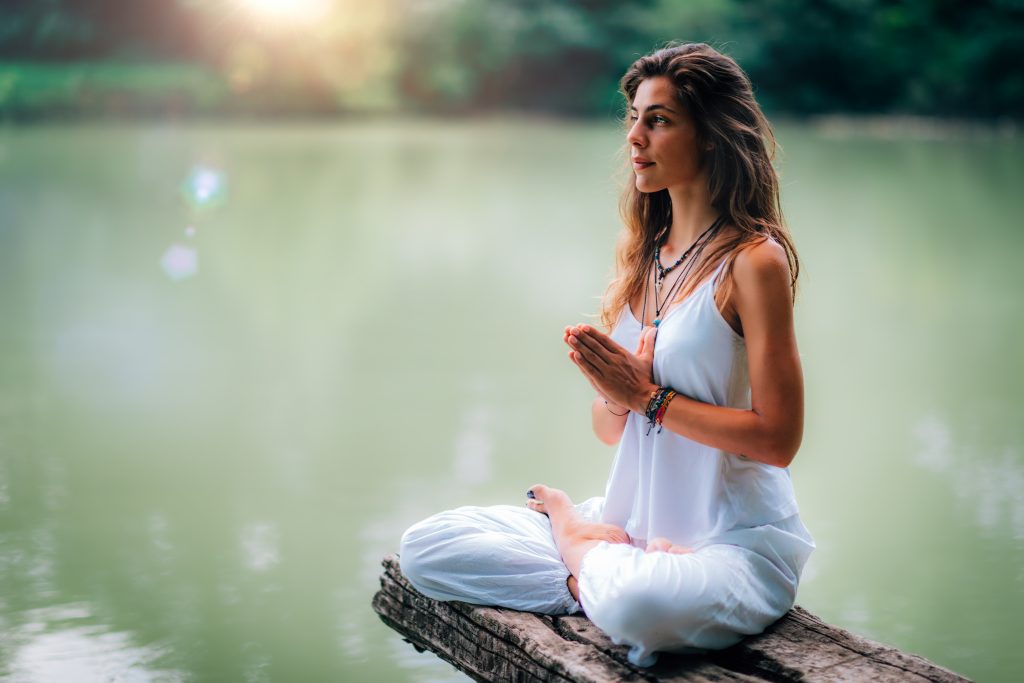
Explanation of Mindfulness Meditation’s Focus on Present Moment Awareness
Mindfulness meditation is a practice that involves cultivating awareness of the present moment without judgement. It encourages you to be fully present, observing your thoughts, feelings, and sensations without trying to change or react to them. By focusing on the here and now, mindfulness meditation helps detach from the worries of the past or future, creating a sense of calm and tranquillity.
Benefits of Mindfulness Meditation
- Reduces Stress and Anxiety- Mindfulness meditation is scientifically proven to reduce stress and anxiety. By training your mind to stay in the present, you minimise the tendency to ruminate over stressful events or anxious thoughts.
- Promotes a Tranquil Mind- This practice cultivates a peaceful mental state by allowing you to observe thoughts and emotions with detachment. This detachment prevents the mind from getting entangled in a cycle of worry.
Simple Mindfulness Meditation Steps Tailored for Sleep Preparation
- Find a Quiet Space- Choose a quiet and comfortable spot where you won’t be disturbed. It could be a corner of your bedroom or a designated meditation area.
- Sit Comfortably- Sit in a comfortable position, whether on a chair or cushion. Keep your back straight but not tense.
- Focus on Your Breath- Close your eyes gently and bring your attention to your breath. Notice the sensation of each inhalation and exhalation.
- Observe Your Thoughts- As thoughts arise, acknowledge them without judgement and then gently redirect your focus back to your breath. Don’t get frustrated—this is a natural part of the process.
- Scan Your Body- After a few minutes of focusing on your breath, slowly shift your attention to different parts of your body. Notice any areas of tension or discomfort.
- Release Tension- As you become aware of tension, imagine sending your breath to those areas. With each exhale, imagine the tension melting away.
- Return to the Present- If your mind drifts into thoughts about the past or future, gently guide it back to the present moment. Use your breath as an anchor.
- Lengthen the Exhale- In the last few minutes of your meditation, gradually lengthen your exhales. This can trigger the body’s relaxation response.
- End with Gratitude- When you’re ready to conclude, take a few deep breaths and open your eyes. Reflect on a few things you’re grateful for.
Mindfulness meditation is a valuable tool for sleep preparation. By practising mindfulness, you quiet the mental chatter that often keeps you awake at night. This helps in creating a mental space conducive to sleep, as worries and anxieties take a back seat. The deep state of relaxation induced by mindfulness meditation encourages a smoother transition into sleep.
Relaxation Technique 4# Visualisation and Guided Imagery
Description of Visualisation Involving Calming Mental Images
Visualisation is a relaxation technique that harnesses the power of your imagination to create serene and soothing mental images. By vividly imagining calming scenes, you transport your mind to a peaceful place, away from the stresses of the day. Visualisation engages your senses and emotions, facilitating a deep sense of relaxation and tranquillity.
Guided Imagery’s Role in Leading the Mind to a Relaxed State
Guided imagery is a variation of visualisation that involves following a recorded narration or script. It directs your imagination towards specific relaxing scenarios, often accompanied by calming background sounds. This type of guided journey helps guide your mind to a deeply relaxed state by providing a focus and structure for your thoughts.
Also Check – How to Practice Visualization Meditation: 3 Best Scripts
Suggestions for Visualisations Related to Peaceful Settings and Scenarios
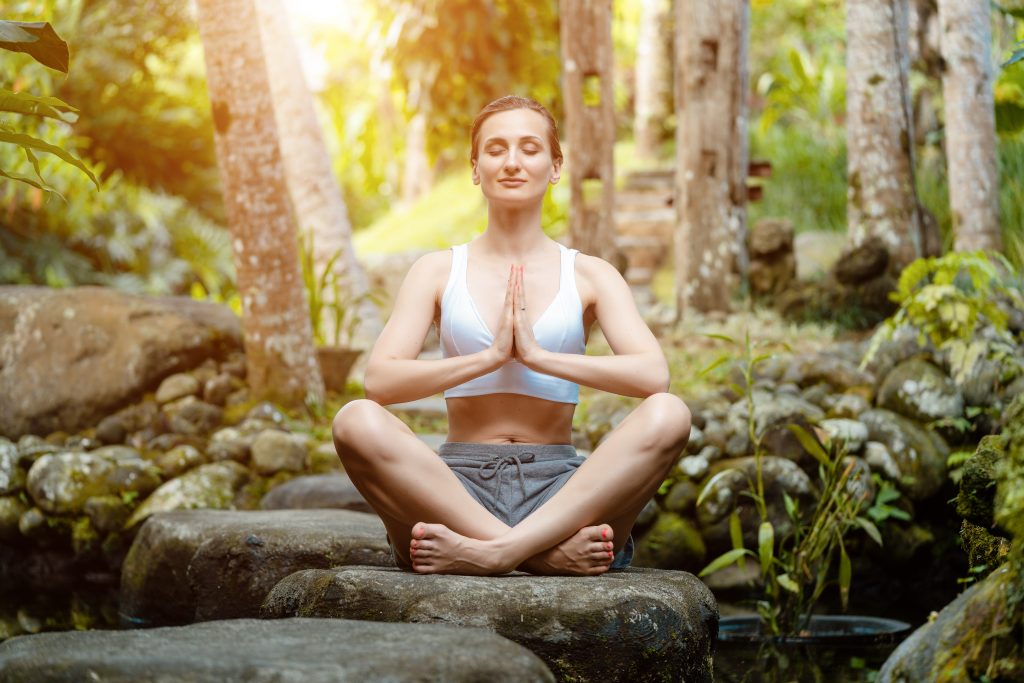
- Beach Sunset- Imagine yourself on a quiet, pristine beach at sunset. Feel the warm sand beneath your feet, listen to the gentle lapping of waves, and watch the sun dip below the horizon.
- Forest Retreat- Picture yourself in a tranquil forest. Inhale the earthy scent of trees, hear the rustling leaves, and visualise beams of sunlight filtering through the canopy.
- Mountain Serenity- Transport your mind to a peaceful mountain peak. Feel the cool breeze, hear the distant chirping of birds, and marvel at the breathtaking view.
- Floating on a Cloud- Envision yourself floating weightlessly on a fluffy cloud in a vast sky. Let go of all worries as you drift peacefully among the stars.
- Candlelit Oasis- Imagine a cosy room softly illuminated by candlelight. Sense the warmth of the flickering flames, and feel a sense of calm enveloping you.
- Underwater Haven- Visualise yourself underwater in a calm, clear ocean. Watch colourful fish swim by, feel the gentle currents, and listen to the soothing sound of water.
- Starry Night- Picture yourself lying in a grassy field under a starry night sky. Gaze up at the twinkling stars and feel a sense of wonder and peace.
Visualisation and guided imagery are effective tools for preparing your mind for sleep. These techniques engage your imagination and divert your attention away from stressors, worries, and racing thoughts. By immersing yourself in calming mental scenarios, you create a mental environment conducive to relaxation and sleep. Guided imagery, in particular, provides a structured path for your thoughts, helping you let go of mental clutter and drift into sleep.
Also Check – Sleep’s Role in Weight Loss- How Insufficient Rest Impacts Progress
Relaxation Technique 5# Aromatherapy
Introduction to the Concept of Using Scents for Relaxation- Aromatherapy is a relaxation technique that harnesses the soothing power of scents to promote relaxation, ease stress, and improve sleep quality. The aromatic compounds found in essential oils interact with your senses, influencing your mood and creating a tranquil environment that supports relaxation.
Sleep-Promoting Essential Oils
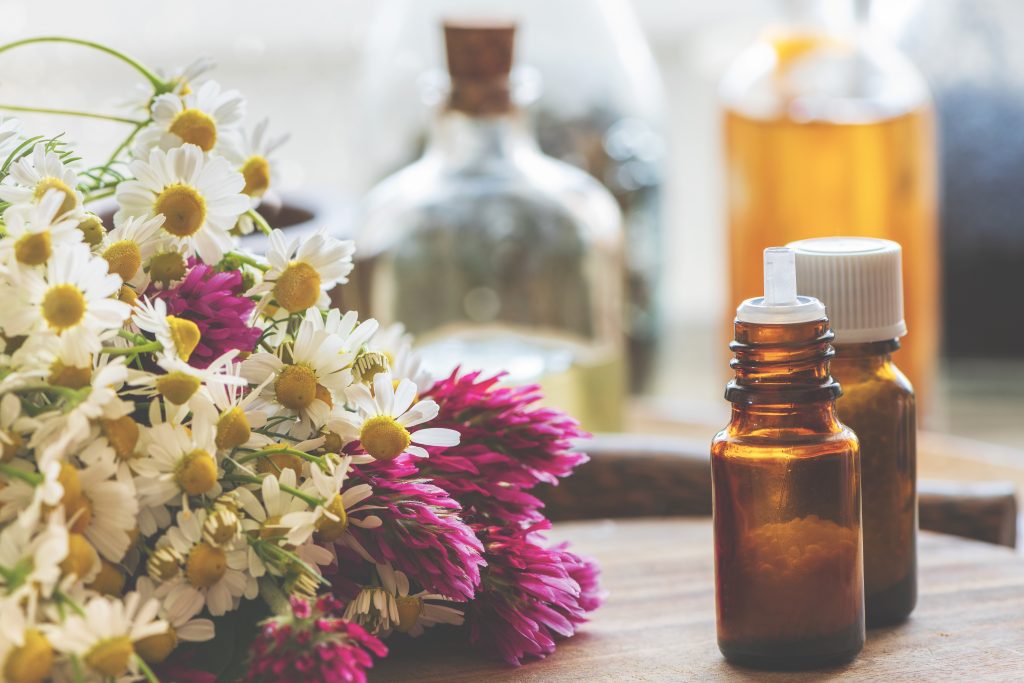
Several essential oils are known for their sleep-enhancing properties-
- Lavender- Lavender is renowned for its calming aroma. Its gentle floral scent has been shown to lower heart rate and blood pressure, inducing a sense of calm conducive to sleep.
- Chamomile- Chamomile’s gentle, herbal fragrance has a soothing effect on the mind and body. It’s often used to alleviate anxiety and promote relaxation, making it a valuable aid for sleep.
- Cedarwood- Cedarwood emits a warm, woody scent that is grounding and calming. It has been used to create a serene environment that encourages relaxation and restful sleep.
Also Check – 9 Powerful Herbs to Help You Sleep Naturally
Ways to Incorporate Aromatherapy
- Diffusers- A diffuser is a popular way to disperse essential oils into the air. It transforms the oils into a fine mist that you inhale, filling your space with the calming scent. Set up a diffuser in your bedroom before sleep for a soothing ambiance.
- Sprays- Aromatherapy sprays combine essential oils with water or alcohol to create a fine mist. You can spritz your pillow, bedding, or room with these sprays to infuse the space with relaxation-inducing aromas.
- Scented Pillows or Sachets- Place a sachet or a few drops of essential oil on a cotton pad and tuck it into your pillowcase. The gentle scent will envelop you as you lay your head down to rest.
- Topical Application- Dilute essential oils with a carrier oil and apply them to pulse points or the soles of your feet before bedtime. The oils are absorbed through the skin, offering a calming effect.
Aromatherapy is a powerful ally in the pursuit of better sleep. The aromatic molecules from essential oils interact with the olfactory system, which is closely connected to the brain’s emotional and relaxation centres. This interaction can help calm racing thoughts, ease tension, and create a serene environment that facilitates the transition into sleep.
Relaxation Technique 6# Warm Bath or Shower
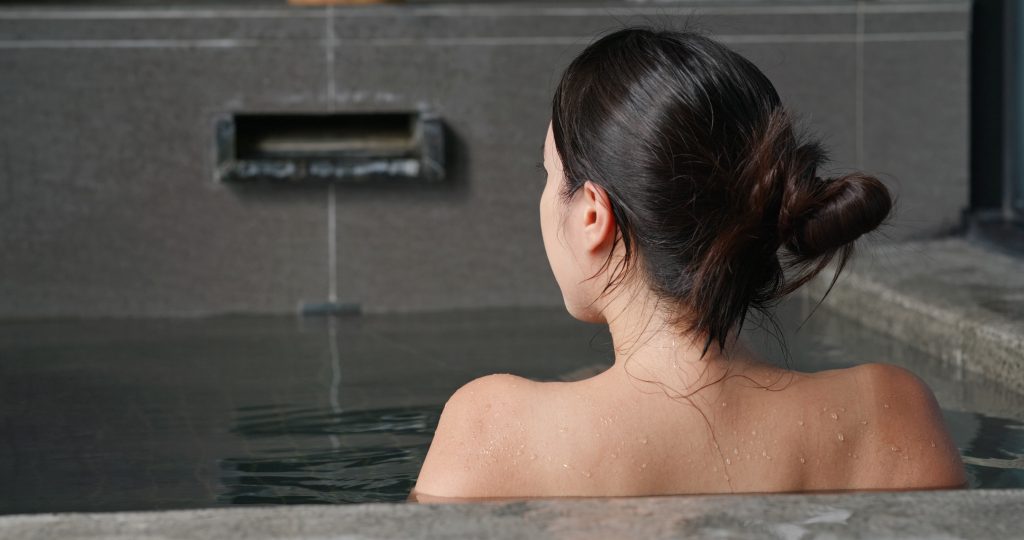
Explanation of How Warm Water Promotes Relaxation and Soothes Muscles
Taking a warm bath or shower before bedtime is a relaxation technique that offers both physical and mental benefits. Warm water helps relax your muscles by increasing blood circulation and reducing muscle tension. It also stimulates the release of endorphins—natural mood enhancers—creating an overall sense of calm and well-being.
While warm water is beneficial, overly hot water can have counterproductive effects. Water that is too hot can lead to increased heart rate, blood pressure, and body temperature, causing a wakeful state rather than relaxation. It’s important to find the right balance in water temperature to achieve optimal relaxation without overstimulation.
Tips for Creating a Calming Bathing Routine Before Bedtime
- Set the Mood- Dim the lights, light some candles, or play soft, soothing music to create a tranquil ambiance in your bathroom.
- Choose Aromatherapy- Add a few drops of calming essential oils like lavender or chamomile to your bathwater. The aromatic scents can enhance the relaxation effect.
- Optimal Water Temperature- Ensure the water is comfortably warm, not too hot. A temperature between 98-100°F (36-38°C) is generally ideal for relaxation without causing overheating.
- Use Epsom Salt- Adding Epsom salt to your bathwater can further soothe your muscles. Epsom salt contains magnesium, which promotes muscle relaxation and overall relaxation.
- Slow Down- Take your time in the bath or shower. Let the warm water envelop you, and focus on the sensations of relaxation as you wash away the stress of the day.
- Mindful Breathing- Practice deep breathing while in the water. Inhale slowly through your nose, and exhale through your mouth. This can amplify the relaxation benefits.
- Disconnect- Consider making your bathing routine a screen-free time. Avoid checking emails, texts, or social media during this time to fully immerse yourself in relaxation.
A warm bath or shower can be a delightful prelude to a restful night’s sleep. The relaxation induced by warm water helps unwind both body and mind, reducing the physical tension and mental stress that might otherwise interfere with sleep. By incorporating a calming bathing routine before bedtime, you set the stage for a smoother transition into sleep.
Relaxation Technique 7# Yoga and Stretching

Brief Overview of How Gentle Yoga and Stretching Ease Tension- Engaging in gentle yoga and stretching exercises is an effective relaxation technique that helps alleviate physical tension and promotes a sense of calm. These activities target tight muscles and encourage them to release, allowing for improved blood flow and enhanced flexibility. The deliberate, mindful movements also direct your focus away from stressors, facilitating relaxation of both body and mind.
Yoga Poses That Aid Relaxation
- Child’s Pose (Balasana)- This resting pose involves sitting back on your heels, folding forward, and stretching your arms out in front of you. It gently stretches your lower back, hips, and shoulders, promoting relaxation and a sense of surrender.
- Legs-Up-the-Wall (Viparita Karani)- Lie on your back and lift your legs up a wall, creating an L-shaped position. This pose encourages blood circulation, reduces swelling in the legs, and calms the nervous system.
- Corpse Pose (Savasana)- Lie flat on your back with arms by your sides, palms facing up. Savasana promotes deep relaxation and is often practised at the end of a yoga session to prepare the body and mind for rest.
- Seated Forward Fold (Paschimottanasana)– Sit on the floor with legs extended, and hinge at your hips to fold forward. This pose stretches the spine, hamstrings, and shoulders, releasing tension and encouraging a sense of calm.
Also Check – A Bedtime Yoga Routine for Peaceful Sleep: 13 Yoga Poses You Can Do in Bed and Beyond
Vigorous Exercises Close to Bedtime
While gentle yoga and stretching are beneficial for relaxation, it’s essential to avoid vigorous or intense exercises close to bedtime. Vigorous physical activity can increase heart rate, body temperature, and adrenaline levels, making it harder to wind down for sleep. These activities stimulate the body rather than preparing it for rest, potentially leading to difficulty falling asleep.
Gentle yoga and stretching provide a holistic approach to sleep preparation. By easing physical tension and calming the mind, these activities create an environment that’s conducive to relaxation and sleep. Incorporating poses like Child’s Pose, Legs-Up-the-Wall, and others into your pre-sleep routine can help release accumulated stress and promote tranquillity.
Relaxation Technique 8# White Noise and Nature Sounds

Concept of Using Background Sounds to Mask Disturbances- White noise and nature sounds are relaxation techniques that involve introducing soothing auditory experiences to create a calming environment. These sounds work by masking disruptive noises that might otherwise interfere with sleep. The consistent, gentle sounds help divert your attention from external disturbances and guide your mind toward relaxation.
Different Types of White noise and nature sounds
- White Noise- White noise is a consistent sound that covers a wide range of frequencies, similar to static on a TV or radio. It’s effective in drowning out irregular noises and creating a steady auditory backdrop that promotes relaxation.
- Rain- The sound of raindrops falling gently can have a calming effect. Rain sounds mimic the rhythmic pattern of nature and can evoke a sense of peace and cosiness.
- Waves- The sound of ocean waves ebbing and flowing can be incredibly relaxing. It reminds us of serene beach environments and induces a tranquil state of mind.
- Forest Ambiance– The sounds of birds chirping, leaves rustling, and gentle wind in a forest create a sense of connection with nature. Forest ambience sounds can transport your mind to a serene woodland, easing stress and tension.
White Noise Machines, Apps or Recordings
- White Noise Machines- These devices generate consistent soundscapes like white noise, ocean waves, or rain. They come in various sizes and offer a dedicated way to play soothing sounds throughout the night.
- Mobile Apps- Many smartphone apps offer a variety of natural sounds and white noise options. These apps are convenient and can be easily customised based on your preferences.
- Online Recordings- Numerous websites and platforms provide free or downloadable recordings of different relaxation sounds. You can find recordings of rain, waves, forests, and more.
White noise and natural sounds can be invaluable aids in improving sleep quality. By creating a peaceful auditory environment, these sounds help block out disruptive noises and encourage a relaxed state of mind. The consistent soundscapes provide a reliable point of focus, making it easier to let go of stressful thoughts and drift into sleep.
Relaxation Technique 9# Herbal Teas and Decaffeinated Drinks

Soothing Herbal Teas
- Chamomile Tea- Chamomile is a well-known herbal remedy for relaxation. Its mild, floral flavour is often accompanied by calming properties that can help soothe nerves and promote a sense of calm before bedtime.
- Valerian Tea- Valerian root is renowned for its potential to reduce anxiety and improve sleep quality. Valerian tea has a subtle earthy taste and is believed to help relax the mind and body.
- Passionflower Tea- Passionflower has been traditionally used to alleviate anxiety and promote relaxation. Its delicate taste can contribute to a peaceful pre-sleep routine.
Decaffeinated Options
- Warm Milk- Warm milk has been a go-to remedy for relaxation for ages. It contains tryptophan, an amino acid that can support the production of the sleep-inducing hormone, serotonin.
- Herbal Infusions- Beyond herbal teas, consider infusing warm water with relaxing herbs like lavender or lemon balm. These infusions offer the calming effects of herbs without the added caffeine.
- Decaffeinated Chamomile Tea- If you’re seeking the relaxation benefits of chamomile without any caffeine, opt for a decaffeinated version. It offers the same soothing qualities without the stimulating effects of caffeine.
Consume These Beverages in Moderation for Better Sleep
While herbal teas and decaffeinated drinks can be beneficial for relaxation and sleep, it’s important to consume them in moderation. Avoid excessive consumption, especially right before bedtime, to prevent disturbances in your sleep due to bathroom trips. Additionally, be mindful of any potential allergies or sensitivities to certain herbs. Herbal remedies can vary from person to person, so it’s a good idea to try different options and see which works best for you.
Sipping on soothing herbal teas and decaffeinated drinks is a gentle way to wind down before bedtime. The warmth and comfort of these beverages, along with their potential relaxation benefits, can help signal to your body that it’s time to relax and prepare for sleep. Just be sure to enjoy them in moderation and avoid consuming large quantities right before bed.
Incorporating relaxation techniques into your routine before bed can improve your quality of sleep. From deep breathing and mindfulness meditation to warm baths, yoga and calming herbal teas, each technique offers a unique path to rest. By relaxing both your body and mind, you pave the way for a restful sleep. Remember to tailor these techniques to your preferences and needs. Avoid strenuous activities just before bedtime and hold back on drinks. Embrace the holistic approach of these methods to create a Soothing retreat that promotes relaxation and prepares you for a peaceful night’s sleep.

Leave a Reply